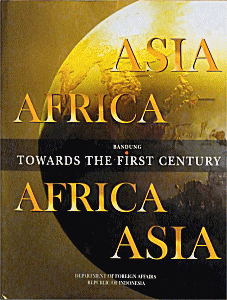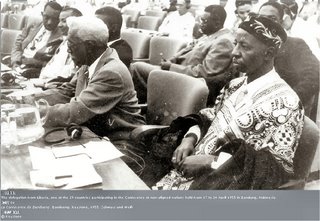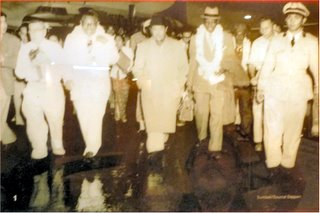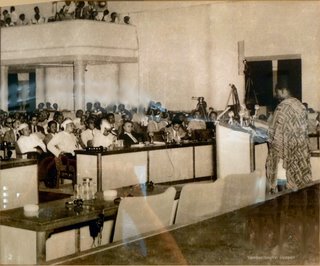



return to current topicalities page | return to Shikanda portal
by Wim van Binsbergen
© 2010 Wim van Binsbergen
Having worked in and on Africa from the late 1960s, the echoes of the 1955 Asia Africa conference still reverberated through my early years of scholarship (in which politics and statehood played a central role), and over the years I have come to internalise the common wisdom that Bandung heralded the final stage in the decolonisation of Africa. Having started my work on sub-Saharan Africa in Zambia, 1971, I had been cherishing the personal myth that Kenneth Kaunda himself (that country's architect of independence and first President) had been to Bandung and had rubbed shoulders there with the great ones of the Non-Allied Movement -- but of course, Kaunda's first visit even to India was only in 1957. Yet perhaps the prominence of the word 'Freedom' in the context of Kaunda's UNIP / United National Independence Party (Freedom House for UNIP headquarters, Freedom Rally for UNIP meeting, etc.) owes something to the Bandung Gedung Merdeka / Freedom Building, as the 1955 conference hall was later renamed (at the time of the conference it was called Gedung Dwi-Warna, 'Two-Colour Building' (betraying the Sanskrit origin of part of the Indonesian lexicon), a name that was later transferred to another historic Bandung building). Fifty years after the conference, in 2005, Indonesia attempted a repeat performance of intercontinental leadership and goodwill. For that occasion the building (originally 'Societeit Concordia', built before World War II as a Dutch colonial club and inevitably a fortress of colonialism and racialism) that had accommodated the 1955 meetings was converted into a modern museum.
The African or Africanist visitor to this museum is in for some surprises. Apparently in true reflection of the historical reality of the mid-1950s, the Museum displays suggest that Africans have hardly played a role at this conference of heads of sovereign states -- of sub-Saharan Africa, only Liberia, Ethiopia and (as borderline cases) Sudan and Gold Coast / Ghana qualified, to which we can add Egypt, Libya and Morocco as the only North African participants (Tunisia and Algeria still being under French colonial rule). On the 1955 conference pictures of plenary sessions and committee meetings, only Asian faces can be made out, some of them still unmistakable and still famous, such as Nehru and Chou En Lai; the only centrally conspicuous African is Egypt's leader cAbd al Nasser. One is hard pressed to find (either at the Museum, or on the Internet) photographs portraying a Black African presence in Bandung at all. Below I am presenting whatever I could locate, apologising for the poor quality of some of the photographs; as well as for the minimal coverage of the Ethiopian participation. Some of the historic pictures derive from the Internet, others were taken from exhibits at the museum (requiring heavy editing because of poor lighting conditions), other yet again from a lavishly produced public relations book the Indonesian Ministry of Foreigh Affairs published in 2005 to mark the 50th anniversary conference:
Department of Foreign Affairs, 2005, Asia Africa / Africa Asia : Bandung: Towards the first century, Jakarta: Department of Foreign Affairs, Republic of Indonesia,
a free copy of which was graciously given to me from restricted stock during my visit to the Museum.
Another surprise is the location of Gedung Merdeka. The building still lies along Bandung's main throughfare (a segment of the old mailroad by which Dutch 'Patriot', francophile and finally Gouvernor-General of the East Indies Daendels rationalised and consolidated the colonial administration of Java in the early 19th century; the city of Bandung was founded in the process), and in proximity of the municipal headquarters and the Great Mosque. In the vicinity of the Museum, the road was renamed Jalan Asia Afrika. However, since colonial times this original town centre has undergone great changes in function and in social status, and Jalan Braga, around the corner from the Museum, is a depressing mixture of decrepit colonial utilitarian architecture (of the type to be found all over once colonised Asia and Africa), and a second-class trading area visibly gone out of fashion as business has moved to Bandung's many splendid modern shopping malls. We will just have to wait a few decades, until this historic centre, now in obvious decay, may once more become fashionable among the urban elite.
A third surprise is that the Museum, inconspicuously, is close to one of the most sacred spots of the city of Bandung -- not only because of the Great Mosque, but also from the perspective of popular religion: separated only from the Museum by the river that flows through Bandung, and now housed in a municipal utilities building, is the 'Head of Bandung' -- the actual spot designated by Daendels for the new town. Allegedly the Bandung area was deserted at the time, but that does not prevent locals adherent to the local Sunda Islamic version of popular religion to use this spot as a cultic centre, under the guidance of urban representatives of the shrine cult of Nagara Padang, on which I report on another 2010 webpage (also cf. my 2007 report)
 |
||
| The Asia Africa Conference
Museum signboard |
The Asia Africa Conference
Museum today |
The 2005 commemorative
volume, which brings out the enormous advances Africa has
made on the global scene since Bandung 1955. In 1955
Africans were still rare, distant, near-mythical beings
from the Indonesian point of view-- in one of the films
shown at the Museum, a middle-aged Bandung lady exclaims
that in the context of the 1955 Conference she had seen
one man, 'totally black, but so big and strong...!' In
2005 African are given pride of place. In addition to the
Indonesia President's name Yudhoyono, the book's title
page is graced by only two more names: those of South
African President Thabo Mbeki and Ghana-born UNO
Secretary General Koffi Annan, while inside the book is a
multi-page official message on Asian African co-operation
from ex-President Nelson Mandela of South Africa. |
| the great conference hall, visited by
a school class of girls from Surabaya; the museum is a
popular destination for school outings |
a film camera used during the
conference, with a picture of one of its operators at the
time |
high-powered Africans at the 2005 Bandung conference, including President Thabo Mbeki and Secretary General Koffi Anan, with their ladies |
| the Indonesian Minister of
Foreign Affairs addresses the 1955 conference |
The club building
'Societeit Concordia', the later conference and Museum
building, in the early 20th century |
Bandung 1955 delegates
were accommodated in the Homann Hotel, shown in the
background right; they daily made the walk to the
conference hall. This is the Liberian delegation walking
across. This picture derives from a Museum exhibit; in
the 2005 book the same picture appears, blown up but
without the three figures foreground left |
| plenary session, Bandung 1955 |
Liberian delegate Momolu Dukuly in
conversatioin with a Roman Catholic prelate and other
observers, Bandung 1955 |
members of the Gold Coast delegation
(central and right) in conversation with other delegates,
possibly (the gentleman left) from Ethiopia, Bandung 1955
|
| African delegates (seated left and
centre, possibly also right foreground) in informal
gathering around the Indonesian Minister of Foreign
Affairs, Bandung 1955 |
delegates from Saudi Arabia (right)
socialising with what may be a member of the Ethiopian
delegation, Bandung 1955 |
plenary session, Bandung 1955; it is
no exageration to say that African were little
conspicuous on that occasion |
 |
 |
 |
| The Liberian delegation,
1955 |
The Sudani and Liberian
1955 delegations are welcomed at the airport |
Mr Bosio of Gold Coast /
Ghana addresses the 1955 plenary meeting |
| The Liberian delegation, 1955 |
President Gamal cAbd
al-Nasser of Egypt / United Arab Republic, most prominent
and conspicuous African at the Bandung 1955 conference |
meeting of the Cultural Committee,
Bandung 1955 |
| Bandung 1955: Liberian delegate Momolu
Dukuly, flanked by a delegate from Sudan or Saudi Arabia |
The conference building during the
1955 Bandung Conference |
Presidents Gamal cAbd al-Nasser of Egypt / United Arab Republic, and Nehru of India (right and centre) |
| The Sudan delegation shows
the first flag of their country, now changed |
adjacent to the Museum, the river, and the municipal utilities building houding the Head of Bandung | detail of the view to the
left; the shining top ornament standardly marks mosques
in Indonesia |
| Jalan Asia Afrika; note
the Javanese script |
photo shoot in front of
the Museum by a uniformed schoolclass of upper-class
Indonesian children wielding expensive, professional
cameras |
Jalan Asia Afrika and
Hotel Homann today |
| Jalan Braga, which (contrary to the rest of Bandung and Indonesia) has seen better times | Jalan Braga today | Tempo Dulu (Up Nostalgia Lane): what was carefully preserved of the Maison Bogerijen pastry shop along Jalan Braga; note the 'Delft Blue' ornamental plates decorating the wall. It is here that 1955 conference delegates are reputed to repair for coffee, cakes, and confidential talks |
| lavish art-deco interior of the former Maison Bogerijen | and that establishment shockingly numerous staff, photographed before WWII |
return to current topicalities page | return to Shikanda portal
page last modified 29-12-2010 00:45:14